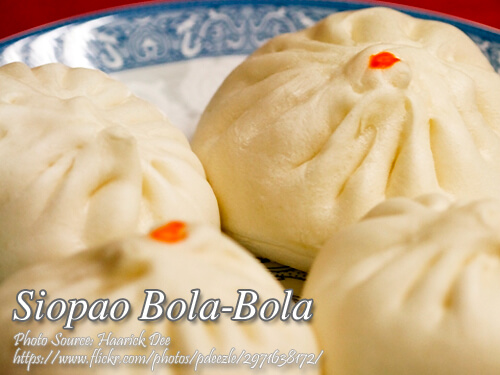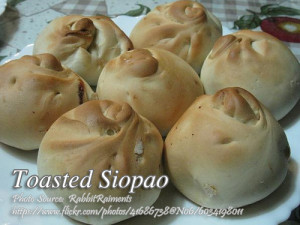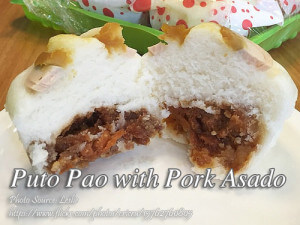This pork siopao is as popular and an all-time favorite siopao next to the siopao asado. This is simpler to make because you don’t need to precook the filling before wrapping it in the siopao dough. You just need to mix the ground pork filling mixture then divide it to whatever number of pieces of siopao you want to make. The filling is also garnished with sliced hard boiled eggs and Chinese sausage before wrapping it inside the dough.
Siopao Bola-Bola: A Taste of Tradition and Nostalgia
Growing up in a big family, siopao was always a staple at our merienda table. Be it some fiesta or just another lazy Sunday afternoon, my family never missed out on this Filipino favorite. My uncle Tito Ramon, a goody-goody who likes spending time in the kitchen, would prepare these steamed buns in big batches for us. He would speak of how he grew up in Manila as a child and learned the recipe from his grandmother. Every time I prepare this dish today, I feel this strong connection to those shared moments and to our rich family’s culinary history.
In our family, we always loved the other variant, the one filled with pork more than the Asado variant. Why, you may ask? Probably because it is not so complicated. Unlike its sweeter counterpart, you don’t have to precook the filling. The seasoned pork mixture is just put inside the dough, wrapped into its soft and fluffy form, making it somewhat easier to prepare, especially for a first time.
The Secret to Perfect Dough
Tito Ramon always insisted that the secret of the great steamed buns was in the dough. He said it had to be soft but strong, capable of not breaking apart when filled. And trust me, that took a lot of practice. He used to tell us little tips he’s learned over the years, such as reminding oneself to make sure that the yeast mixture is activated properly. The trick was in letting the yeast and sugar mixture sit for about 10-15 minutes in lukewarm water, he said. It should bubble slightly, Tito would say with a wink. That’s when you know the yeast is alive and kicking.
The ready yeast is mixed into a combination of flour, sugar, salt, and a bit of oil. This combination of the ingredients gave us a dough so smooth, elastic, and soft to the touch. We would let it rise by resting after kneading on a floured surface. I can still recall that Tito covered the dough with wet cloth and left it to sit near the window where the sun warmth kissed it during the afternoon. It was already ready to shape within 30 minutes to 40 minutes. That’s how long it took for it to double in size, indicating it was ready for shaping.
Filfilling with Flavors: Pork to Chinese Sausage
In filling it out, my cousin Ate Malou has her own little twist. She would add finely chopped onions and garlic to the ground pork mixture for that extra layer of flavor. It was only soy sauce, salt, sesame oil, and a little flour as a binder in the old version. More aromatics added to it made it all the more irresistible. What more becomes delightful about this dish is how the filling gets garnished with slices of hard-boiled egg and Chinese sausage before getting wrapped into the dough.
I can still vividly remember the first time that I attempted making the filling myself. I divided the mixture into small, uniform portions just as Tito Ramon suggested. Ensuring that every portion was wrapped carefully inside a dough ball contained two slices of Chinese sausage and one slice of a boiled egg in the middle. I folded the dough over to cover the filling and twisted it at the top like you do with siomai. It was almost like therapy, seeing all those small buns rise to such perfection.
The Ritual of Steaming
Of course, the most exciting part is steaming the buns for us kids. As a full bamboo steamer loaded with the aroma of freshly cooked buns, we would gather around the kitchen. In traditional ways, siopao is steam-cooked in bamboo baskets, I think which imbues a unique flavor and almost brings nostalgia. In addition, one has to place each bun on a small square of wax paper so that it won’t stick to the steamer.
They would emerge soft and fluffy after about 20 minutes of steaming, piping hot. Tito always served it with spicy vinegar or a smudge of soy sauce, but I like mine without any additions; I just add a simple dash of hot sauce. And what can compare with the experience of the first bite: the breaking through the delicate dough into the savory filling inside?.
A Little History of Siopao
This steamed bun originated from China but was deeply embraced by the Filipino plate. The term “hot bun” actually characterizes the Siopao. This dessert came into the country courtesy of Chinese immigrants. And it has been a staple breakfast food in many parts of the Philippines. Through the years, Filipinos have modified the recipe according to local tastes, and it has become one of the most popular street foods and snack items. Whether you step into a hectic big city market or a small, unassuming provincial town, you are sure to find siopao steaming hot in large metal pots and ready for local and visitors’ consumption.
A Recipe Passed Down
Every time I make steamed buns, I remember Tito Ramon and lazy afternoons spent at the kitchen with the family. The preparation of this recipe reaches beyond the pages; it is a connection to the past, an honoring of the people who came before us, and the reminder of how food can bring everyone together.
Any individual wanting to try making this recipe has no cause to worry. And the task itself, with some patience and love, is not as hard as it might look. “The best dishes are those done with heart” Tito Ramon. Make time to enjoy the process and share it with your loved ones once you’re done.
How to Make Siopao Bola-Bola
Ingredients
For the siopao dough:
- 2 tsp. dry active yeast
- 4 cups flour
- 3 Tbsp. shortening or lard
- 3/4 cup sugar
- 1 1/4 cups warm water
- 1/4 tsp. salt
For the bola-bola filling:
- 1/2 kilo ground pork
- 2 Tbsp. soy sauce
- 1 tsp. salt adjust if nessesary
- 2 Tbsp. sesame seed oil
- 2 Tbsp. all-purpose flour
- 2 pieces Chinese sausage sliced into 1/4-inch thick pieces
- 2 pcs hard-boiled eggs or salted duck eggs cut each lengthwise into 4 pieces
Instructions
How to make the dough:
- Soften yeast and 1 tablespoon sugar in lukewarm water. Set aside for from 10 to 15 minutes.
- Mix together sugar, salt, and oil in a bowl. Add softened yeast. Add half of the flour and mix well.
- Add remaining flour and continue mixing till well blended; knead on floured board until smooth.
- Shape the dough into a ball and place in a greased bowl. Grease surface of dough.
- Cover with wet cloth and let rise for from 30 to 40 minutes in a warm place.
- Punch down dough, divide it into 90 grams pieces (or just divide it into 8 pieces), form into balls and let them rise again for 30 minutes.
How to make siopao bola-bola:
- Mix first 5 ingredients (pork, soy sauce, salt, sesame seed oil and flour). Divide into 8 pieces and form into balls.
- Place one ball in the middle of a round flattened 90 grams siopao dough piece, add 2 slices of sausage and a slice of egg.
- Wrap the filling (similar to wrapping a siomai filling with wanton wrapper) and seal the dough by twisting the top and shape into small balls.
- Place a piece of clean wax paper at the bottom of the balls to prevent them from sticking to the steamer.
- Let the balls rise for from 1 to 1 1/2 hours or until double in bulk.
- Steam in bamboo steamer over rapidly boiling water for 20 minutes. Enjoy hot with your favorite hot sauce.
Notes
Cooking Tips:
Activate the Yeast Right
Activating the yeast properly is one key to a light and airy bun. Mix it in lukewarm water and sugar, and let the mixture stand for 10-15 minutes until it becomes frothy. If the yeast doesn't seem to bubble, either your yeast is old or your water is too hot or too cold to create a good rise.Knead Dough Properly
Knead the dough until it is smooth and elastic. It will give a soft airy texture. Don't add too much flour if the dough is too sticky. Adding more than the required amount of flour will make the buns heavy. The gluten develops properly within the dough through proper kneading, which in turn provides this dough with its structure and chewiness.Steam Over Rapidly Boiling Water
Let the water boil rapidly before putting your buns in the steamer. This way, perfectly steamed buns will be ready for you. This ensures that the buns would cook perfectly and rise well without getting soggy at the bottom. Lifting the lid too often can help to avoid the steam inside the steamer, and the siopao needs sufficient time to be cooked through and perfectly steamed.






WOW just what I was searching for. Came here by searching for bola-bola
Thanks for this siopao bola bola recipe but I also need the siopao sauce. Can u also post it?
Hi Dan, you can use the siopao asado sauce which you can see on my siopao asado recipe post.